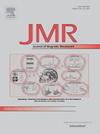Homonuclear decoupled INADEQUATE NMR methods with improved sensitivity and resolution in solid-state NMR
IF 1.9
3区 化学
Q3 BIOCHEMICAL RESEARCH METHODS
引用次数: 0
Abstract
The two-dimensional (2D) refocused INADEQUATE NMR experiment, which correlates double-quantum (DQ) and single-quantum (SQ) coherences, is widely used to probe the chemical connectivities in solids. Nevertheless, the multiplets along the F2 dimension reduce the resolution and sensitivity of this experiment. The Composite-Refocusing (CR) technique with two excitation pulses has been proposed to suppress these multiplets in 2D INADEQUATE spectra of liquids. Recently (Kolyagin et al., J. Phys. Chem. Lett., 13 (2022) 10793), we showed that this technique can also be applied to suppress doublets in 2D 29Si INADEQUATE spectra of 29Si-enriched zeolites, which resulted in improved sensitivity and resolution. We investigate here how this INADEQUATE-CR scheme can also be applied for two other spin-1/2 isotopes: 13C and 31P. We also demonstrate the possibility to accelerate the acquisition of these 2D INADEQUATE-CR spectra with a very simple bi-exponential non-uniform sampling (NUS). For instance, in the case of 31P nuclei in SnP2O7, the use of the INADEQUATE-CR method with NUS yields a 7.5-fold reduction in experimental time with a simultaneous 1.4–1.5 gain in resolution with respect to a conventional INADEQUATE acquisition. Furthermore, we analyze the origins of the possible artifacts in these 2D spectra, including mismatching between J-coupling constants and refocusing delays, differences in relaxation times, coupling with a proton bath, and spin systems containing multiple identical nuclei. Based on this analysis, we introduce a new z-filtered INADEQUATE-CR version, which produces artifact-free 2D spectra, even in the presence of several distinct J-couplings and relaxation times or for multi-spin systems, and notably samples with high proton density.

同核去耦 INADEQUATE NMR 方法,提高了固态 NMR 的灵敏度和分辨率。
二维(2D)重聚焦的不充分核磁共振实验,将双量子(DQ)和单量子(SQ)相干性联系在一起,被广泛用于探测固体中的化学连通性。然而,沿F2维的多重波降低了本实验的分辨率和灵敏度。为了抑制液体二维不充分光谱中的多重重聚焦现象,提出了双激发脉冲复合重聚焦(CR)技术。最近(Kolyagin et al., J. Phys.)化学。列托人。, 13(2022) 10793),我们发现该技术也可以应用于抑制29Si富沸石二维29Si不充分光谱中的双峰,从而提高了灵敏度和分辨率。我们在这里研究了这种insufficiate - cr方案如何也适用于另外两种自旋为1/2的同位素:13C和31P。我们还证明了用非常简单的双指数非均匀采样(NUS)加速获取这些二维indue - cr光谱的可能性。例如,在SnP2O7中的31P核的情况下,与传统的不充分获取相比,使用NUS的insufficiable - cr方法可以使实验时间减少7.5倍,同时分辨率提高1.4-1.5倍。此外,我们还分析了这些二维光谱中可能的伪影的来源,包括j耦合常数和重聚焦延迟之间的不匹配,弛豫时间的差异,与质子浴的耦合以及包含多个相同原子核的自旋系统。基于这一分析,我们引入了一种新的z-滤波的in充分- cr版本,即使存在几个不同的j耦合和弛豫时间或多自旋系统,特别是具有高质子密度的样品,也能产生无伪影的二维光谱。
本文章由计算机程序翻译,如有差异,请以英文原文为准。
求助全文
约1分钟内获得全文
求助全文
来源期刊
CiteScore
3.80
自引率
13.60%
发文量
150
审稿时长
69 days
期刊介绍:
The Journal of Magnetic Resonance presents original technical and scientific papers in all aspects of magnetic resonance, including nuclear magnetic resonance spectroscopy (NMR) of solids and liquids, electron spin/paramagnetic resonance (EPR), in vivo magnetic resonance imaging (MRI) and spectroscopy (MRS), nuclear quadrupole resonance (NQR) and magnetic resonance phenomena at nearly zero fields or in combination with optics. The Journal''s main aims include deepening the physical principles underlying all these spectroscopies, publishing significant theoretical and experimental results leading to spectral and spatial progress in these areas, and opening new MR-based applications in chemistry, biology and medicine. The Journal also seeks descriptions of novel apparatuses, new experimental protocols, and new procedures of data analysis and interpretation - including computational and quantum-mechanical methods - capable of advancing MR spectroscopy and imaging.

 求助内容:
求助内容: 应助结果提醒方式:
应助结果提醒方式:


